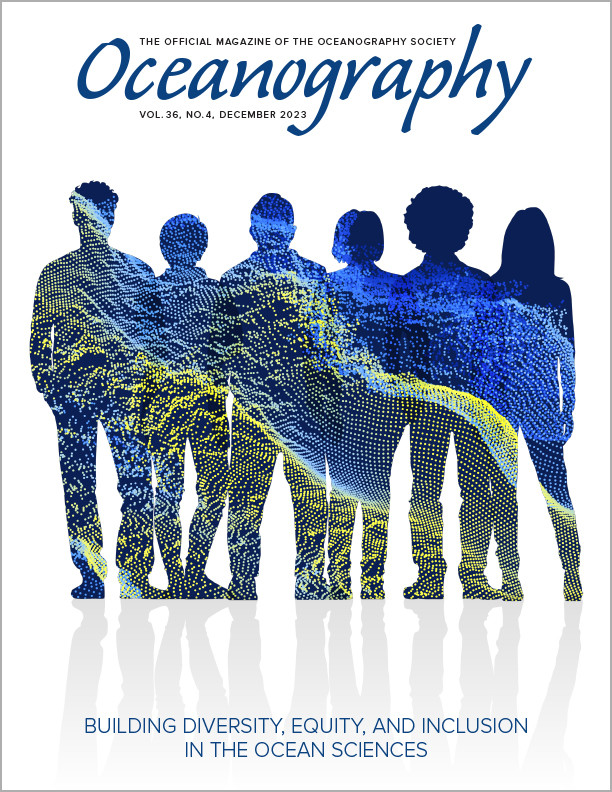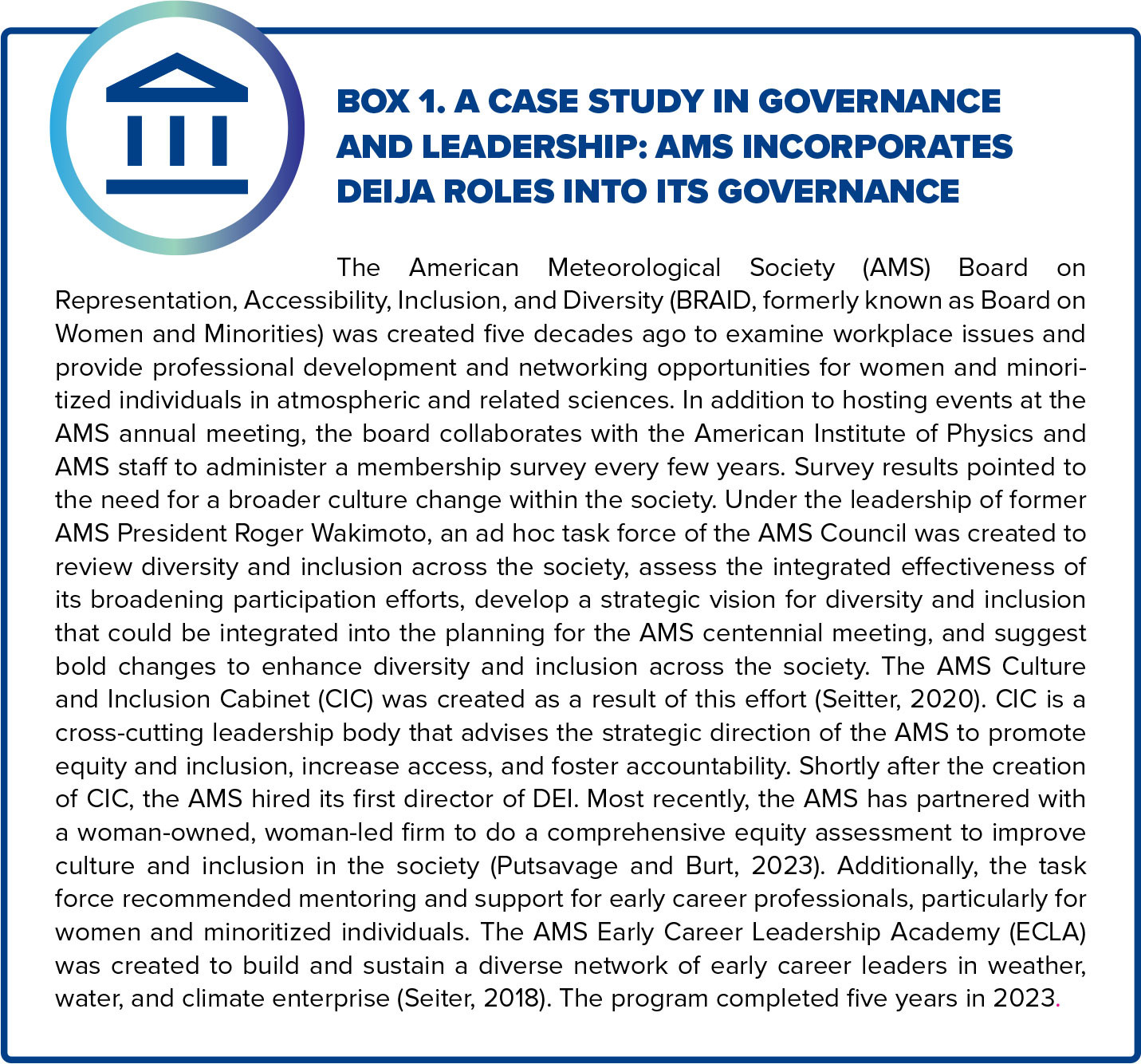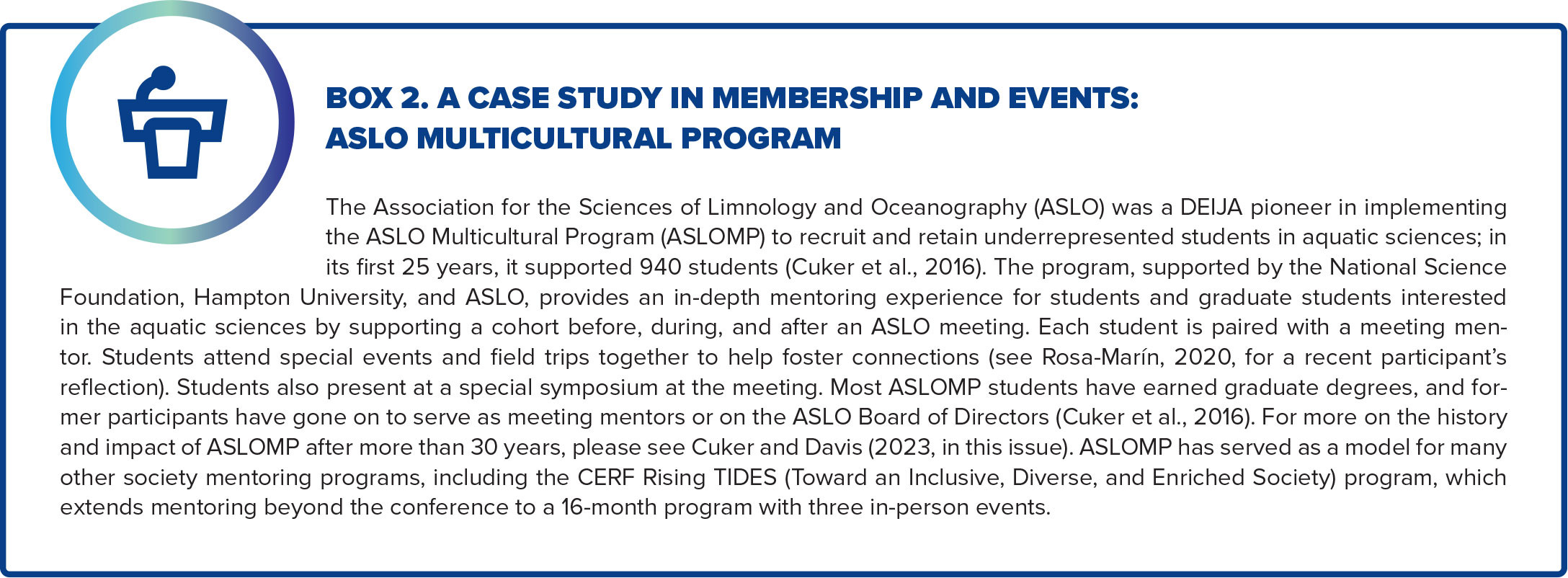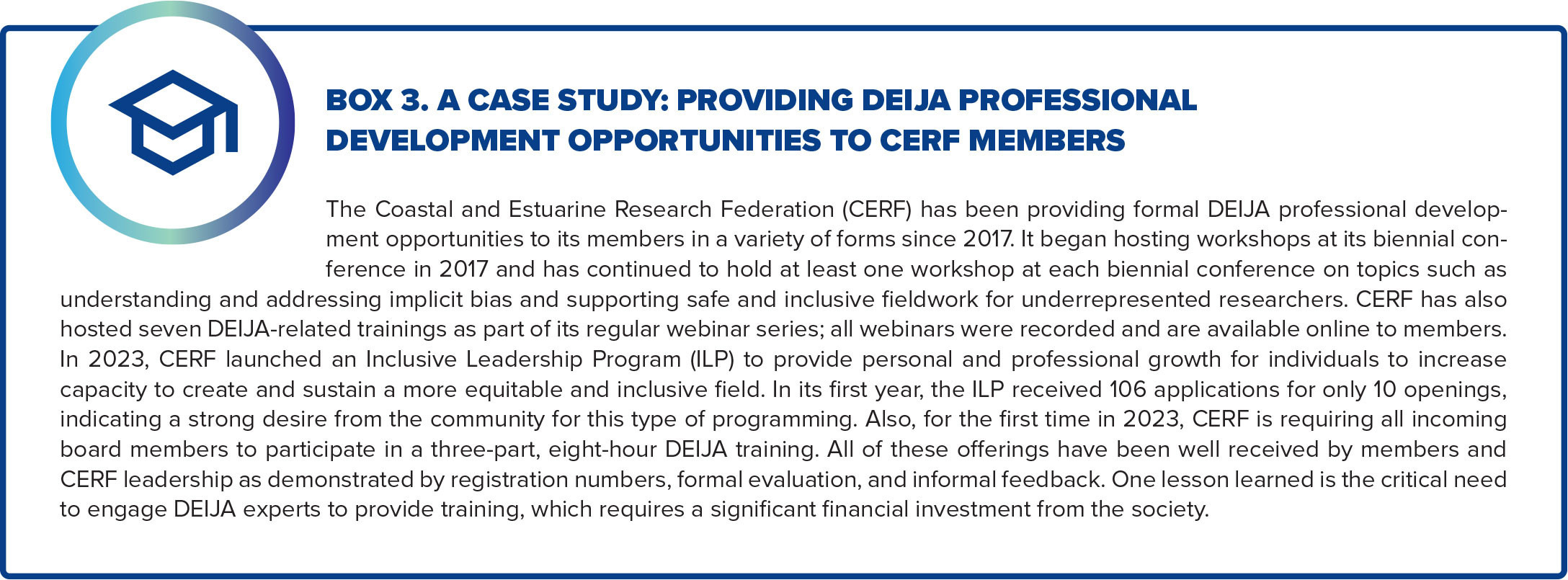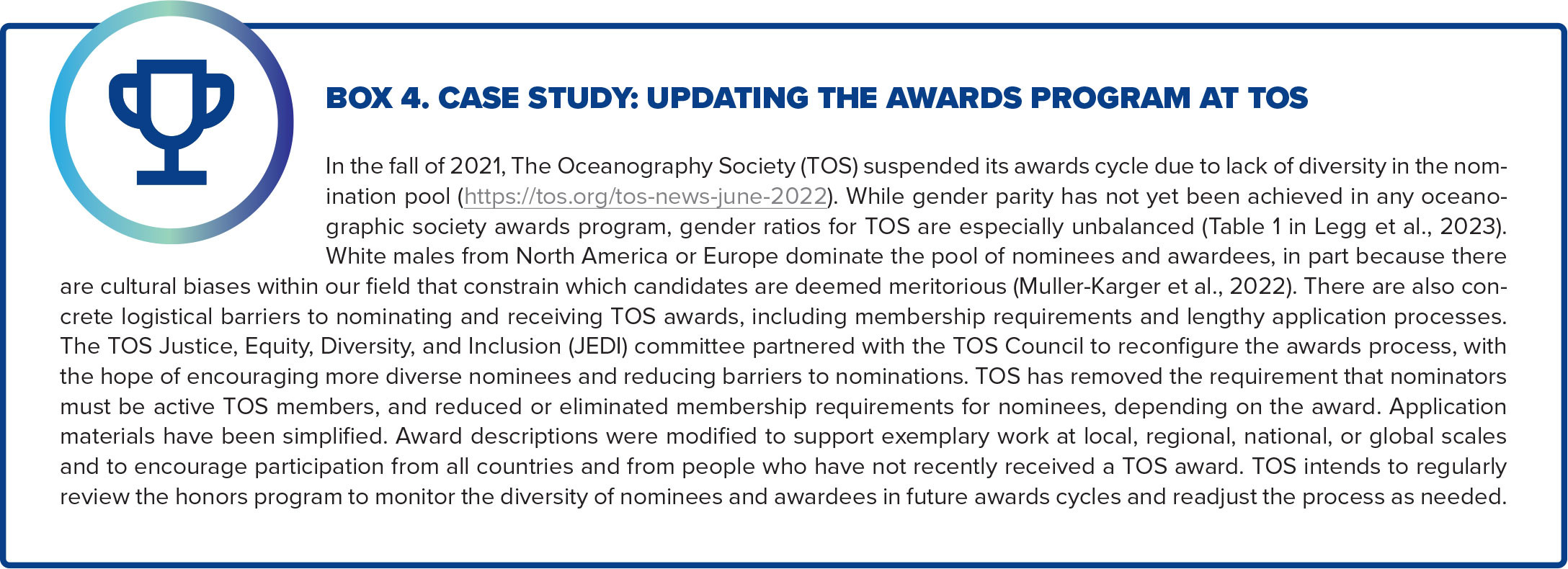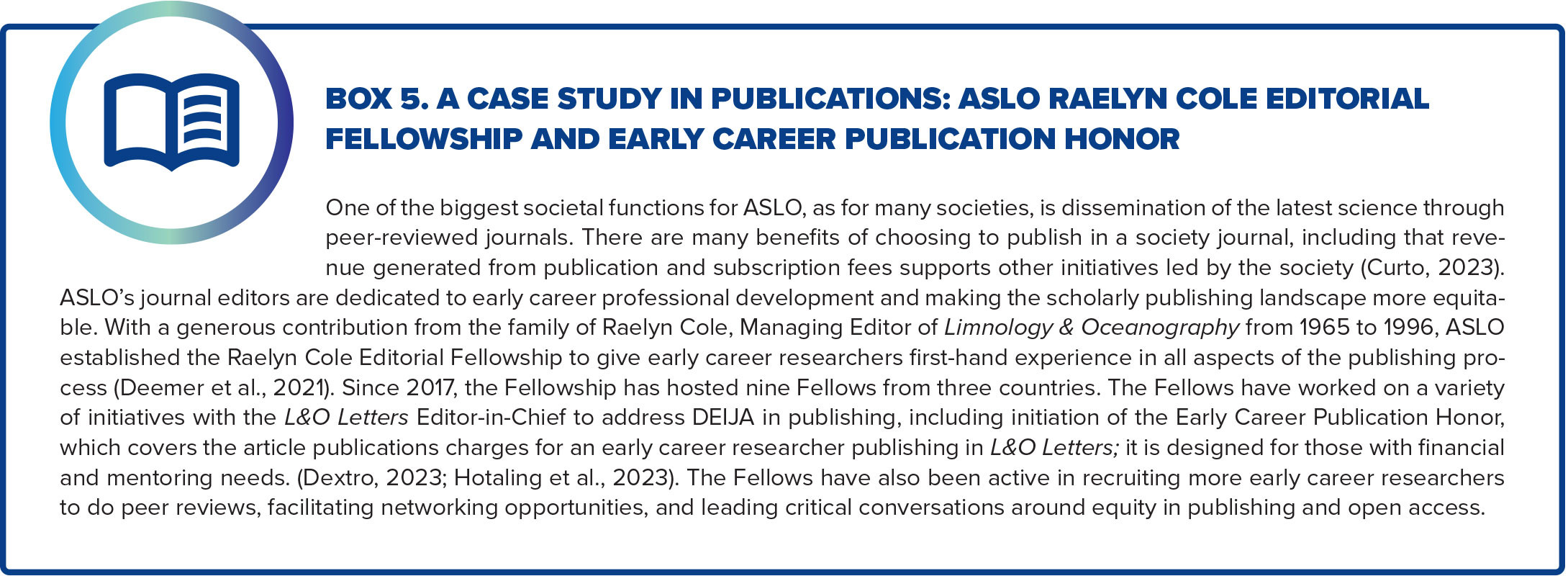Introduction
Professional societies in the sciences serve broad communities and bridge institutions, which uniquely positions them to influence cultural change within their associated fields. Societies provide leadership within fields through highly visible, wide-reaching services, such as publishing flagship journals, hosting conferences, and conferring awards and honors. Additionally, professional societies provide career enhancement and advancement opportunities for members from different backgrounds and for all career stages. A recent survey of the ocean sciences community found that professional societies were considered very important for catalyzing positive changes in the field (Meyer-Gutbrod et al., 2023). As such, professional societies are well-positioned to steward diversity, equity, inclusion, justice, and accessibility (DEIJA) goals of disciplines and professions.
Using examples from five societies, this review aims to highlight ways in which professional societies can integrate DEIJA into their functions and improve the culture of ocean sciences. Based on a classification scheme used by ACCESS+ (Amplifying the Alliance to Catalyze Change for Equity in STEM Success), professional societies serve the following 12 functions for their disciplines and membership: (1) governance and leadership, (2) membership, (3) meetings, conferences and events, (4) professional development, (5) chapters and affiliates, (6) awards and recognition, (7) marketing and communications, (8) community outreach and engagement, (9) employment, (10) public policy and advocacy, (11) publishing, and (12) partners, sponsors and vendors (Figure 1; Campbell-Montalvo et al., 2022a; Leibnitz et al., 2022). The professional societies highlighted in this paper are the American Geophysical Union (AGU), the American Meteorological Society (AMS), the Association for the Sciences of Limnology and Oceanography (ASLO), the Coastal and Estuarine Research Federation (CERF), and The Oceanography Society (TOS). The following sections of this paper discuss and give examples of these 12 functions.

FIGURE 1. Schematic showing the 12 functions of professional societies. The center shows the five ocean-related professional societies featured in this article that provide examples of advancing diversity, equity, inclusion, justice, and accessibility in these 12 functions. > High res figure
|
Functions of Professional Societies
1. Governance and Leadership
Governance boards of professional societies are bodies that establish and safeguard professional standards, manage resources, recognize individuals, influence policy, and respond to societal needs. Serving on governance boards offers a path to leadership. In addition to providing valuable service to their profession, board members play a crucial role in preventing unwanted behavior; reforming ineffective policies, procedures, and practices; and fostering culture change. Some strategies that professional societies can use to meld DEIJA into their governance and leadership include recruiting DEIJA staff, engaging members from marginalized backgrounds to gather information about their needs, and articulating a society’s DEIJA vision and aligning it with the overall development and implementation of a society’s strategic plan. Societal governance can include boards and committees that directly address DEIJA efforts, such as AMS’s Board on Representation, Accessibility, Inclusion, and Diversity (Box 1); the TOS Justice, Equity, Diversity, and Inclusion Committee; AGU’s Diversity and Inclusion Advisory Committee; and ASLO’s Race Relations Task Force. Finally, to incorporate DEIJA into the primary governance structure, societies like CERF require board members to complete DEI training.
2. Membership
Membership is a cornerstone of professional societies: members pay dues for the benefits that a society provides, plan and implement many of the activities as volunteers, and elect a volunteer board of directors that leads the organization. Broad and diverse membership is critical to advancing DEIJA in professional societies. Progress toward DEIJA goals should be clearly tracked, measured, and communicated to the membership (e.g., Abernethy et al., 2020; Leibitz et al., 2022). Tools like CERF’s climate survey can be used to solicit direct input from members from underrepresented groups and identify the unique needs and concerns of those members (Madzima and MacIntosh, 2021). Societies like CERF, AMS, AGU, and ASLO collect and regularly update baseline demographic data to determine whether recruitment and retention efforts are successful. However, it is challenging for societies to decide what demographic data to collect, how to collect it, how to use it, and how to protect member privacy (Burnett et al., 2022).
One strategy for recruiting members from underrepresented and marginalized groups is to partner with Minority-Serving Institutions (MSIs), including Historically Black Colleges and Universities, Tribal Colleges and Universities, and Hispanic-Serving Institutions. Professional societies can also collaborate with organizations that are focused on fostering the success of individuals from underrepresented groups, such as the Society for the Advancement of Chicanos/Hispanics and Native Americans in Science (SACNAS), Black in Marine Science (BIMS), and Association for Women in Science (AWIS). Member dues can be a significant financial burden for individuals from underrepresented groups and for members from developing countries. Societies can improve recruitment by addressing financial barriers to membership; for example, ASLO and CERF provide tiered rates for members in emerging or developing nations, and student membership in TOS is free. AMS rates are based on earned income, and the society offers a special membership rate to individuals from developing economies. Finally, mentoring is a major contributor to the retention of individuals from underrepresented backgrounds in STEM disciplines (Allen-Ramdial and Campbell, 2014; Johnson et al., 2016; NASEM, 2020). Society-sponsored mentorship programs like ASLOMP (Box 2) provide a pathway for accessing diverse mentors with inclusive mentorship training.
3. Meetings, Conferences, and Events
Regularly scheduled meetings and conferences offer opportunities for society members to network; share research, educational opportunities, and job announcements; and participate in society-centered activities such as membership renewal, elections, and awards ceremonies. However, both policies and cultures surrounding conferences can systematically exclude participants, especially members of underrepresented groups, due to issues associated with costs, travel, caregiver responsibilities, safety, and biased speaker selection (King et al., 2018; Ford et al., 2019; Legg et al., 2023). Incidents of microaggressions and personal harassment in conference settings can further exclude and traumatize participants (Jackson, 2019; Dewsbury, 2020; Flores, 2020).
Societies can create more safe and inclusive conference experiences to support the diverse needs of presenters and attendees (Sardelis et al., 2017). To ensure DEIJA in conferences, planning committees should be diverse, with a subcommittee directly responsible for incorporating DEIJA. All five ocean societies discussed here have developed Codes of Conduct for events and implementation plans that include reporting mechanisms and sanctions for violators. Venues and the surrounding city should be safe, inclusive, and accessible. This may include ADA-compliant facilities; gender-inclusive restrooms; the ability to share pronouns on name badges; comfortable lactation rooms with electrical outlets, sinks, refrigerators, and microwaves; onsite or nearby childcare; quiet or prayer rooms; instructions to presenters on making presentations more accessible; providing chairs and microphones for all speakers; accommodating dietary restrictions and other special needs; having access to motorized scooters or other mobility assistance devices; spaces and resources for caregivers; and allowing caregivers and children to attend conference events (Barrows et al., 2021; Jack-Scott et al., 2023). AGU, ASLO, and TOS sponsor affinity events, town halls, and relevant panels (e.g., Meyer-Gutbrod, 2021; Pierson, 2023, in this issue) and facilitate a mentorship program at biennial Ocean Sciences Meetings. AMS meetings include events like Colour Of Weather (for Black and African-American members; Joseph et al., 2008), the CoRioliS Reception (for LGBTQIA+ members), Women’s Luncheon, spirituality and multifaith discussions, and a DEI symposium. Local Indigenous members may be included in planning and plenary sessions, and a land acknowledgment should be provided at the opening of the conference (Barrows et al., 2021). Tiered registration fees and student travel grants help support participants with financial needs (Segarra et al., 2020). The advent of virtual and hybrid conference options may be a partial solution to the barriers associated with travel, costs, and caregiving (Estien et al., 2021).
4. Professional Development
Professional societies provide important career development opportunities to their members through conferences and workshops, offering online learning resources, hosting trainings, providing continuing education credits and technical certifications, publishing recurring newsletters, hosting websites with job postings, and sharing information about funding opportunities. For example, ASLO offers the Limnology and Oceanography Research Exchange (LOREX) and Ecological Dissertations in Aquatic Sciences (Eco-DAS) programs, AMS offers the Early Career Leadership Academy (ECLA), and CERF offers the Inclusive Leadership Program (ILP, Box 3). Professional societies also sponsor programs that facilitate mentorship and networking, like AGU’s LANDInG (Leadership Academy and Network for Diversity and Inclusion in Geosciences) programs. Society-sponsored training programs typically provide content that is not offered in standard higher education curriculum or by employers; therefore, professional societies can fill an important gap in education, including on DEIJA topics.
5. Chapters and Affiliates
Chapters and affiliates can take many forms, from student chapters at specific universities, to regional organizations, to disciplinary or thematic groups. Because chapters and affiliates are often based at a local or regional level, they often have strong connections to students, as well as smaller or less-resourced academic institutions (e.g., K–12 institutions, two-year colleges; MSIs; state and local government agencies; and regional, state, and local for-profit and nonprofit organizations). For example, AMS has over 130 local chapters, providing an effective means of increasing awareness of meteorology and atmospheric science among the general public. All of these connections may help in recruiting a more diverse membership, as participation in chapters and affiliates may require a lower financial commitment (e.g., local conferences will have lower travel costs). However, chapters and affiliates are also often governed and run solely by volunteers, limiting their capacity for outreach. The well-resourced parent society can assist smaller chapters and affiliates by sharing best practices and lessons learned such as diversity statements, codes of conduct and ethics, procedures for investigating complaints and taking corrective measures, inclusive meeting practices, and guidance on collecting demographic data. For example, CERF sought legal counsel to develop an extensive Event Code of Conduct, then shared it with their affiliate societies.
6. Awards and Recognition
Awards administered by professional societies recognize exemplary scientific achievements and leadership within their fields. Prior to the twenty-first century, women were largely excluded from prestigious awards (O’Connell, 2014), although ocean-related societies have been making progress toward gender parity in recent decades (Holmes et al., 2020; Legg et al., 2023). However, international societies tend to disproportionately bestow awards to scientists from North America and Europe, especially the United States (Wickland and Pollard, 2019; Muller-Karger, 2022), and there is a stark lack of racial and ethnic diversity among award recipients, although data summarizing these trends are limited.
Burdensome, secretive, or ambiguous processes for award nomination and selection are a barrier to developing a diverse and equitable awards program (Nature, 2022). Recommendations for reducing bias in the awards process include reframing award criteria to be more holistic, advertising awards programs broadly, diversifying awards committees, providing implicit bias training, and regularly reevaluating nomination and selection processes (Lincoln et al., 2012; Cadwalader et al., 2014; Holmes et al., 2020). New awards, such as AGU’s Lifetime Achievement Award for Diversity and Inclusion, can bring recognition to people and efforts that were previously disregarded. Making award nomination data publicly available is one way to shed light on issues with diversity and equity in award dissemination, and these data have been recently published by several ocean-related societies (e.g., Wickland and Pollard, 2019; Holmes et al., 2020; Legg et al., 2023). Efforts to update the awards and recognition programs are ongoing in several societies such as TOS (Box 4), AMS, CERF, and ASLO, with the hope of generating a more diverse and representative pool of nominees and, ultimately, award recipients in ocean science societies.
7. Marketing and Communications
Marketing and communications inform members, potential members, and the broader public about the society’s goals, values, initiatives, events, and services and contribute to recruitment and retention of members. A society’s marketing and communications strategy includes regular messages to members via email, social media, event and content marketing, and advertisements. Regular distribution of DEIJA materials helps society membership continually engage in these valuable discussions, as in the TOS Justice, Equity, Diversity, and Inclusion column in Oceanography magazine, and ASLO’s “Diverse Voices in the Aquatic Sciences” Virtual Issue featuring articles from the L&O Bulletin. Societies can also reflect their commitment to DEIJA goals in all marketing and communication activities by using strategies for avoiding bias and engaging in more inclusive, equitable, and accessible marketing and communications (e.g., Black, 2021). For example, communications officers can educate themselves on best practices for using bias-free language, such as with the American Psychological Association’s Guidelines for Bias-Free Language. Materials should use accessible colors and fonts, text can be translated into multiple languages and braille, and images should include alternative (alt) text and captions. When done thoughtfully, marketing and communications can have a positive impact for advancing DEIJA.
8. Community Outreach and Engagement
Due to their boundary-spanning role, professional societies play an important function in developing and maintaining relationships among diverse groups in the community, including those in public, private, and academic sectors. Professional societies provide a forum for community engagement by providing useful resources, disseminating evidence-based information, coordinating community-led activities, and supporting citizen science. For example, AGU’s Thriving Earth Exchange program connects local communities with experts, practitioners, and professionals to help address local problems. AMS launched an initiative called the Weather Band to connect weather enthusiasts with experts, practitioners, educators, and students in the weather, water, and climate science enterprise. The ASLO Global Outreach Initiative funds mini grants for ASLO members to conduct communication and engagement projects in their communities.
Societies can also foster community outreach and engagement by leveraging their local chapters and meetings. Annual meetings serve as important forums for connecting community members with scientists and professionals regarding local environmental concerns, facilitating research on local issues, administering small grant programs, and serving as opportunities for society members to engage in educational and mentorship activities. For example, AMS hosts WeatherFest at its annual meeting to provide engagement opportunities for the local community. The ASLO Storytellers Series program connects scientists with local schools and libraries to read books about aquatic science to children during the conference week.
9. Employment
Professional societies serve a critical role in helping members find new jobs and networking opportunities to advance their careers. All five societies represented in this paper host career center websites to make job opportunities transparent and accessible. Societies can also provide specific training and development for individuals from underrepresented groups. There is a “hidden curriculum” (Koutsouris et al., 2021), particularly in higher education but also in the workplace, that advantages majority or privileged groups. For example, students who are the first in their families to attend college are likely to lack guidance when applying and interviewing for graduate school and, therefore, may not know about criteria that programs and potential advisors consider in selecting students. Professional societies can provide training in how to apply to graduate school and identify mentorship, support, and networking opportunities with potential graduate school advisors who can help level the playing field (Estien et al., 2021). Increasingly, professional societies are providing training to members on inclusive practices for hiring diverse employees and recruiting students from underrepresented groups, as well as for retaining these employees and students. This training can illuminate practices that may bias the hiring process, such as gendered language and requiring GRE scores. When these efforts succeed in the hiring of a more diverse workforce, this can stimulate a more inclusive work or learning environment and create ripple effects throughout a discipline.
10. Public Policy and Advocacy
Professional societies play a vital role in shaping public policy by facilitating scientific exchange, providing information to legislators through white papers and testimonies, and mobilizing grassroots engagement on important societal matters. What sets professional societies apart is their ability to conduct nonpartisan, independent analysis; communicate with officials on non-legislative matters; and uphold the highest professional standards. They contribute guidelines to ensure effective use of science in decision-making, and influence policies that can help recruit and retain more diverse members, such as those concerning hiring, tenure, promotion, and recognition. Additionally, professional societies shape a discipline’s culture by promoting scientific ethics and integrity policies, thus aiding organizations, institutions, and governments in incorporating scientific assessments into policy development and implementation.
Professional societies also help members engage effectively with policy and policymakers. AMS accomplishes this goal through the organization’s Policy Program, which conducts studies and analysis, drafts policy memos and letters, and organizes congressional visit days. AMS also hosts an immersive Summer Policy Colloquium to provide policy education and training to scientists and professionals and provides financial support to students and faculty from MSIs and HBCUs. ASLO and CERF are both members of the Consortium of Aquatic Science Societies, which works collaboratively to engage on policy issues. Professional societies are often viewed as neutral brokers of knowledge, and due to this positionality, they can often increase the impact of the scientific community and influence policy decisions.
11. Publishing
Professional societies fulfill a vital role by publishing journals that relay recent scientific advancements, support hypothesis development, and combat misinformation. These publications, aside from fostering community development and interdisciplinary collaboration, also impact professional recognition and career progression. However, evidence shows that peer-reviewed journals are prone to biases that disadvantage authors from marginalized groups (e.g., Liu et al., 2023; Smith et al., 2023), prompting the need for DEIJA integration into publishing policies. The Council of Science Editors recommends strategies like accountability, DEIJA-related guidelines, intentional statements, fair representation, inclusive language, demographic data collection, and acknowledging progress and missteps.
Scholarly publishing is undergoing a notable shift toward open access (OA), driven by external policies and rising author interest. For example, the TOS flagship journal Oceanography is fully OA, making robust research as well as articles on ocean education and DEIJA publicly available. While OA enhances research access, the financial burden of publication fees poses challenges, particularly for students and researchers from smaller institutions or low-income countries. The move to OA involves transformative agreements between institutions and publishers, but awareness gaps persist. Scientific societies can play a pivotal role in this transition, representing member interests, engaging in negotiations, and educating members; see Box 5 for a description of ASLO’s Raelyn Cole Editorial Fellowship. Societies can also allocate such resources as publication waivers to address financial barriers responsibly. The push for OA aligns with external forces including the 2022 Nelson Memorandum and Plan S to shape a more equitable and accessible publishing landscape.
12. Partners, Sponsors, and Vendors
In addition to what professional societies offer in conference programming and professional development, there has been an increasing number of partnerships designed to offer resources, DEIJA expertise, and access to new networks. Societies can catalyze DEIJA progress within their fields by partnering with communities of practice that focus on assisting institutions and organizations with the advancement of DEIJA goals. New communities of practice, such as ACCESS+ and COSEA (Coastal and Ocean STEM Equity Alliance), are composed of diverse leaders who are providing a bolus of fresh energy into efforts to advance DEIJA (Campbell-Montalvo et al., 2022; Lewis et al., 2022). These initiatives also provide bridges between professional societies in overlapping fields to promote shared learning and growth.
Another way in which professional societies can help to advance DEIJA is by partnering with ongoing programs that provide opportunities for underrepresented and marginalized groups; these programs include STEMSEAS, a National Science Foundation-funded program that provides ocean-going experience to students (Cooper and Lewis, 2017); Black in Marine Science; Latino Conservation Week; Earth Science Women’s Network (Adams et al., 2016); and the Woods Hole Partnership Education Program (Scott Price et al., 2020). Societies can also raise awareness of these transformative opportunities within and outside of their membership.
Conclusions
This article describes some of the actions and lessons learned in advancing DEIJA through each of 12 distinct functions of professional societies. Case studies from five different ocean-related societies demonstrate specific DEIJA efforts that societies are uniquely positioned to take. The examples we chose to highlight are not representative of all ocean-affiliated societies, nor do they provide an exhaustive list of DEIJA-related efforts within these five societies; however, they demonstrate the range of roles a professional society can play in changing the culture of the ocean and coastal science disciplines to be more inclusive, equitable, and just.
Ocean science professional society members represent a range of disciplines, organization types, and career levels, and they can bring much needed improvements in the culture to fruition. Through its 12 functions, a professional society can have an outsized impact on the careers of individuals in the field. There are many scenarios where creating a more equitable professional society can lead to a more equitable culture in a discipline overall. For example, society-sponsored funding and mentorship for an underrepresented student may ultimately lead to a graduate position or permanent career. A journal editor who is provided training in implicit bias may make more equitable editorial decisions on hundreds of manuscripts. Faculty members or administrators who are promoted due to leadership and service to their professional societies may use their skills to implement more equitable hiring or tenure and promotion practices in their home institutions. People serving on professional society boards, committees, and councils can steward fair governance policies and practices that empower all members to actively engage in advancing a society’s mission. Societies can act as standard bearers, standard setters, change leaders, and regenerative gatekeepers (i.e., Lewis et al., 2022). The activities of a society can have ripple effects throughout its discipline.
The strength of each society lies in its membership. For professional societies to lead culture change within the field of oceanography, they need ideas, energy, and engagement from members spanning all career stages, social identities, subfields, and locations. Please consider becoming more active in a professional society. Vote in the board elections, nominate a colleague for an award, respond to surveys, volunteer for a committee, take advantage of society-offered DEIJA training, or get involved in conference planning. This kind of participation offers a valuable opportunity to meet colleagues outside of your network, develop your skills, engage in meaningful service to your field, and raise your voice to improve the culture within ocean sciences.

